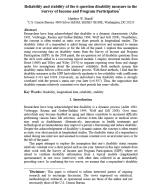
An official website of the United States government
Here’s how you know
Official websites use .gov
A .gov website belongs to an official government organization in the United States.
Secure .gov websites use HTTPS
A lock (
) or https:// means you’ve safely connected to the .gov website. Share sensitive information only on official, secure websites.
-
//
- Census.gov /
- Census Working Papers /
- Reliability and stability of the 6-question disability measure in SIPP
Reliability and stability of the 6-question disability measure in the Survey of Income and Program Participation
Reliability and stability of the 6-question disability measure in the Survey of Income and Program Participation
Introduction
Researchers have long acknowledged that disability is a dynamic characteristic (Adler 1992, Verbrugge, Reoma and Gruber-Baldini 1994, Wolf and Gill 2008). Nonetheless, the concept is often treated as static over short periods in longitudinal studies. The disability status of a respondent is asked during one interview and assumed to remain constant over several interviews or for the life of the panel. I explore this assumption using reoccurring data on disability status from the Survey of Income and Program Participation (SIPP). In the 2008 panel, the six-question set of disability questions from the ACS were added to a reoccurring topical module. I employ structural models from Heise (1969) and Wiley and Wiley (1970) to separate reporting error from real change under two assumptions about the measures’ reliability. Both methods assume that disability status follows a first-order Markov process. With these methods, I find that the disability measures in the SIPP had relatively mode rate to low reliability with coefficients between 0.414 and 0.638. Conversely, an individual’s true disability status is strongly correlated with the person’s status one y ear later (r=0.937). Thus, the supposition that disability remains relatively consistent ov er short periods has some validity.
Share
Related Information
WORKING PAPER
Disability Working PapersSome content on this site is available in several different electronic formats. Some of the files may require a plug-in or additional software to view.
 Yes
Yes
 No
NoComments or suggestions?


Top

